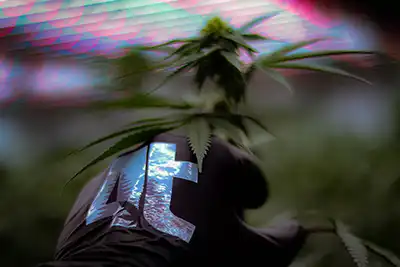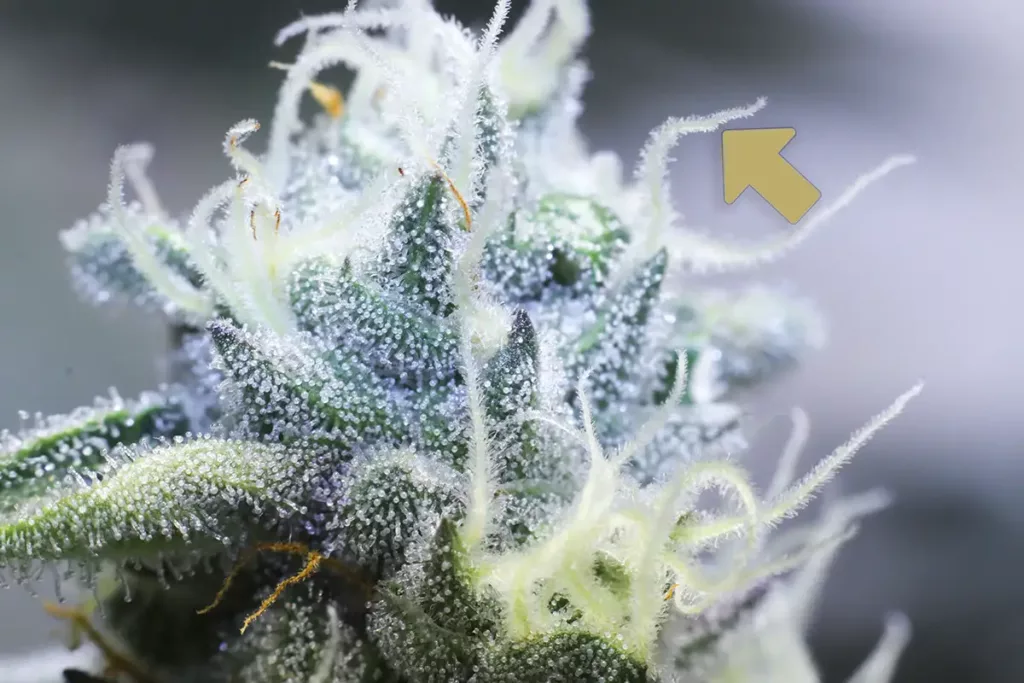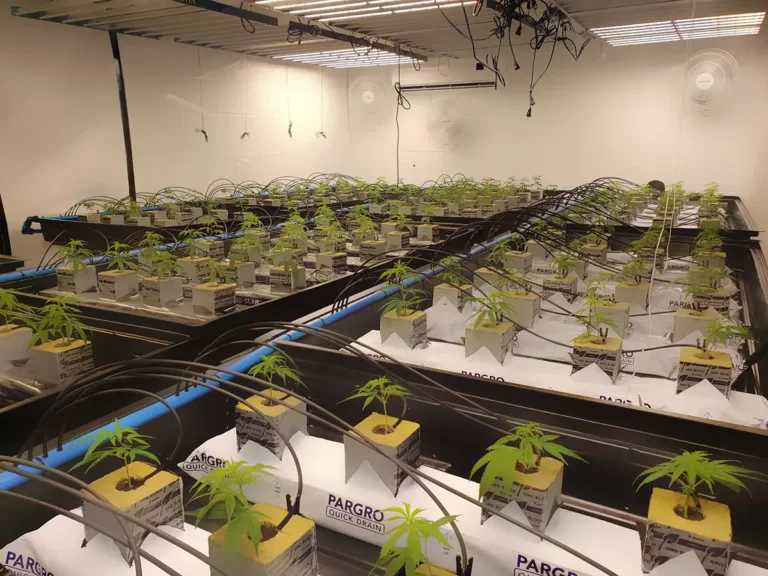Cannabis cultivation is a labor of love and time, but it can also have high operating costs involved. Skipping out on a proper ripening phase means ruining your entire crop, flushing money and time down the drain.

Properly ripened flowers will exhibit a much more profound aroma, look and taste while the THC and other cannabinoids will have a better, more usable effect on the body while exhibiting their true structure. Most importantly it will burn properly and you will only be ingesting the flower, not any nutrients or additives.
If you run a medical grow room (ACMPR), micro cultivation facility or a licensed producer you owe it to yourself and your customers to implement proper ripening techniques so that your product is clean and passes lab inspection.
Red Hairs & Why They Are Important
The Stigma, aside from grandma’s views on marijuana is the portion of the cannabis bud similar to a hair as seen here on one of our Velvet Breath cultivars here. Otherwise known as a “pistil” or red hair due to their tendency to turn red during the final ripening stages.
The stigmas main purpose for the plant is to aid in reproduction. When the male cannabis plant drops its pollen sacks they open up and release a fine powder through the air. These fine hairs are comprised of thousands of other tiny hairs that act as a sponge to absorb any nearby floating pollen.

The stigmas grow out from the calyxes and are what comprises the flowers we know and love today. The purpose of the calyx or ultimately, the bud, is to protect the plants seeds. However, in most scenarios with indoor growing cultivators just want females without any males nearby.
Your stigmas will be white or soft yellow to start turning to a shade of amber upon ripening as you can see with some of the stigmas to the lower left of this photo. Some strains stigmas turn slightly different hue’s but are often shades of red.
How To Know When To Flush
So you understand what the stigmas purpose is, now lets learn how to harness that knowledge!
When your plant(s) pistils darken in color (generally amber) with an overall amount of 60% – 75% darkened coverage its time to start the flushing phase for 2 – 3 weeks depending on the strain.
- Read your plants hairs (stigmas), NOT the calendars.
- Initiate the flushing phase when 60% – 75% of the stigmas have darkened.
Don’t Read The Calendars? – Making notes and marking dates is very important. It just becomes a problem when people blindly follow what the genetics, or seed company suggests that the strain takes and harvest on that day.
Those are merely suggestions based on the growing environments and tests done by the breeder. However, all growing conditions, stress, light intensity, c02 amounts etc. are different variables that play a big role in the finish time of a plant regardless of its strain.
That combined with the fact that every strain takes on different traits from the mother or father means that not all seeds are the same and reading the plant is the most professional, craft growing route to take that will allow your plant to ripen to their full potential.
The Flushing Phase
Flushing should not be overlooked for a successful crop. Its importance spans so much further than just flushing the plant of stored nutrients to avoid smoking them (yeah, that’s a thing). Introducing a proper flushing phase on your cannabis plants will completely transform your garden, and for the better!
Flushing will cause the plants to cannibalize themselves, eating up and utilizing stored nutrients in the leaves causing them to yellow. During this time your plants calyxes or buds will swell and harden while the stigmas turn amber at an accelerated rate. Starting the flushing phase when your stigmas have turned roughly 60% – 75% on your plants will allow adequate time for the plants to finish throughout their final 14 – 28 days of clean, plain water.
Mostly all of your stigmas, or hairs will be red at the end of the flushing phase meaning that the plant has ripened to its fullest, growing it past this would diminish the potency and too soon would reduce the strains potential.
Commonly 14 days is enough time for flush with most strains, so why would you want to flush longer? – In an ideal indoor growing system each grow room has its own strain to make things easy on the cultivator. However, this is not always the case with growers. Many times we just want to play around and grow multiple strains in the same grow room or system and not take things too seriously.
In this case you may start flushing your garden and realize that two weeks in some strains need more time, not to worry! Flushing for longer will only help the plants ripen and finish up.
Lets Chat Plants
Going A Step Further
When its just about time to harvest you can look a little deeper into things and grab a 5x microscope or good camera to view the trichomes. Many phones now days have good enough cameras that you can zoom in and view your trichomes just fine.
The head of the trichome will be a clear ball most of its life and towards the end it will turn milky white, then amber and finally a darker shade of red as it begins keeling over and dying (we don’t want that!). Many people will choose to harvest based on the trichome head color as its said that the milky white colored heads produce a more uplifting cerebral high vs their amber counterparts producing a more couch lock high.
- Use a 5x microscope or good camera to see trichome development.
- Don’t let the trichomes die (growing past 100% stigma coloration)
Flushing Amounts
The flushing phase is not the same as your normal water feeds. You will want to feed the plants more than normal with clean non pH adjusted water. It is not necessary to adjust your pH when flushing, this is because of not having nutrients in the tank. The only reason you would want to adjust the pH is so that your plant takes in the right category of nutrients, so without nutrients this eliminates the need for adjustment. More importantly you don’t want to add things to your water at this point and increase PPM levels.
In soil, coconut husk or rockwool growing you will need to feed your plants three times more then normal during flush, but in recirculating hydroponics you will want to release and refill your system three times more then usual.
When in drain to waste style growing systems do not let your run off water sit in your saucers or tables. This will allow your expelled nutrients built up in your root base or medium wash off. Of course, it is still just as important to flush for the full 14 – 28 day period to allow the plant to go through the ripening process, cannibalizing its leaves, packing on THC and weight.
- Drain To Waste Systems: Increase feeding frequency by the power of 3
- Recirculating Hydroponics Systems: Increase system flush frequency by the power of 3
Environment
Controlling your grow rooms environment properly will be the key to growing craft quality cannabis.
As soon as you see your stigmas are at the 60% – 75% mark you need to lower your light intensity to 40% – 50%. This mimics the sun being further from the plants toward the end of the summer due to the earths axis and allows your buds to harden and become dense.
Temperature and c02 should also be dropped at this point beginning gradually.
- Lower temperature in the room by 6 – 8 degrees Celsius during the first week of flush.
- Lower light intensity to 40% – 50% when starting flush.
- Cut off c02 enrichment completely when starting flush.

Advanced Ripening Techniques
Advanced ripening techniques will bring out beautiful fall colors in your flowers along with pronounced flavors and aromas. These purples and blues are caused by a pigment or flavonoid found in cannabis called anthocyanins.
This pigment is brought out with cold temperatures in the grow room and root zone. Aside from colors and the additional terpenes that come with it, colder temperatures will add stress to the plants which in turn creates more THC and other cannabinoids.
Cold Water Ice Treatment: This method involves chilling the medium or root zone of the plants. This can be done by cooling the feed water with blocks of ice and turning your water chillers down as low as possible. You can also add ice above the plants (blocks are best).
THC and other cannabinoids are a defiance mechanism for the plants. Although we like THC for other reasons, the plant uses it to protect itself from the elements and bugs. With this knowledge in mind you can understand why certain added stress techniques like this can increase potency.
Adding more stress like the cold water technique towards the end of the plants life will help bring out more of what we love!
Armageddon
During the final 48 hours of a plants life you can implement what we call “Armageddon” to induce a massive final push of cannabinoids and colors to the plant via light and temperature stress.
During this last 48 hours you will want to keep the rooms completely dark and as cold as possible.
This technique is great for sugaring up the inside of a neglected canopy that got too thick on you by harvesting the top layer of finished flowers and then leaving the inside of the canopy for the Armageddon phase.
- Only implement the Armageddon phase for the final 48 hours.
- Make rooms as dark and cold as possible for 48 hours.
- Be gentle when harvesting cold cannabis as the trichomes are more brittle at this point.
These ripening techniques and all the methods offered by 4trees Cannabis Building are the results of over 25 years in the “field”. We’re glad to be able to share our knowledge with the world and help shape the craft cannabis industry.
Please let us know how this may have helped you!

